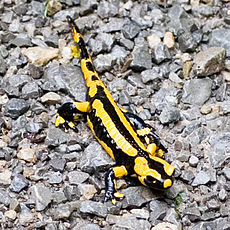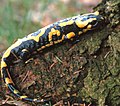Fire salamander
| Fire Salamander | |
|---|---|

| |
| Scientific classification | |
| Kingdom: | |
| Phylum: | |
| Class: | |
| Order: | |
| Family: | |
| Genus: | |
| Species: | S. salamandra
|
| Binomial name | |
| Salamandra salamandra | |
The Fire Salamander (Salamandra salamandra) is probably the most well-known salamander species in Europe. It is black with yellow spots or stripes to a varying degree; some specimens can be nearly completely black while on others the yellow is dominant. Shades of red and orange may sometimes appear, either replacing or mixing with the yellow according to subspecies. Fire Salamanders can have a very long lifespan. In the German natural history museum of Alexander Koenig a salamander lived for more than 50 years.
Habitat, diet, and Other
Fire Salamanders live in forests in the hilly parts of southern and central Europe. They prefer deciduous forests, as they like to hide in the fallen leaves, but also at mossy tree trunks. They need clean small brooks in their habitat for the development of the larvae. Whether on land or in water, fire salamanders are inconspicuous. They spend much of the time hidden beneath stones, wood or other objects.
Fire Salamanders are active in the evening and the night, but on rainy days they are active in daytime as well. Their diet consists of various insects, spiders, earthworms and slugs, but they also occasionally eat small vertebrates like newts and young frogs. Small prey will be caught within the range of the adheres the prey. The fire salamander can grow to around 8 inches.
==Re Nominae Herpetofaunae Europaeae:
Salamandra salamandra (Linnaeus, 1758)
- England - Fire salamander, Spotted salamander
- France - Salamandre commune
- Spain - Salamandra común
- Italy - Salamandra pezzata
- Netherlands - Vuursalamander
- Norway - Ildsalamander
- Slovenia - Navadni močerad
- Croatia - Pjegavi daždevnjak
- Serbia - Šare ni daždevnjak
- Hungary - Foltos szalamandra
- Poland - Salamandra plamista
- Romania - Salamandra comuna
- Israel - סלמנדרה כתומה
Subspecies
- S. s. almanzoris - Spotted Fire Salamander
- S. s. bejarae (or hispanica)
- S. s. bernardezi (extinct?)
- S. s. beschkovi
- S. s. crespoi
- S. s. fastuosa (or bonalli) - Yellow Striped Fire Salamander
- S. s. gallaica - Portuguese Fire Salamander
- S. s. gigliolii
- S. s. infraimmaculata
- S. s. longirostris - Los Barrios Fire Salamander
- S. s. morenica
- S. s. salamandra (or werneri)
- S. s. semenovi
- S. s. terrestris - Barred Fire Salamander
Gallery
References
- Template:IUCN2006 Database entry includes a range map and justification for why this species is of least concern






